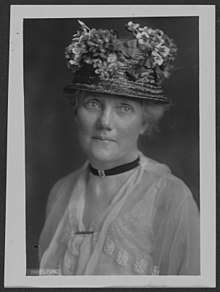Dora Lewis
| Dora Kelly Lewis | |
|---|---|
 | |
| Born |
Dora Kelly October 13, 1862 |
| Died | January 31, 1928 (aged 65) |
| Nationality | American |
| Known for | Suffragist |
| Relatives | Howard Atwood Kelly (brother)[1] |
Dora Lewis (October 13, 1862 – January 31, 1928), also known as Mrs. Lawrence Lewis, was an American suffragist.[2][3] She was active in the National American Woman Suffrage Association and later helped found the National Woman's Party.[4] In 1913 she became an executive member of the National Women's Party, in 1918 she became their chairwoman of finance, and in 1919 she became their national treasurer.[2] In 1920 she headed their ratification committee.[2]
She was part of the Silent Sentinels pro-suffrage protest.[5]
She was arrested many times for her actions in support of suffrage; specifically, she served three days in jail for picketing in July 1917, was arrested on November 10, 1917 and sentenced to 60 days, was arrested in August 1918 at the Lafayette Square meeting in honor of the late Inez Milholland (where she was the primary speaker) and sentenced to 15 days. Later she was arrested in January 1919 during the watchfire demonstrations (which she began when she set fire to copies of President Wilson's speeches on democracy) and sentenced to five days.[6][4][7]
On the night of November 14, 1917, known as the "Night of Terror", the superintendent of the Occoquan Workhouse, W.H. Whittaker, ordered the nearly forty guards to brutalize the suffragists there, which included Dora Lewis.[4] The guards threw Dora Lewis into a dark cell and smashed her head against an iron bed, which knocked her out. Her cellmate, Alice Cosu, who believed Lewis to be dead, suffered a heart attack. According to affidavits, guards grabbed, dragged, beat, choked, pinched, and kicked other women. Newspapers carried stories about how the protesters were being treated.[8] Dora Lewis went on a hunger strike while at Occuquan.[4]
After the Nineteenth Amendment was passed through Congress, Dora Lewis went throughout states such as Georgia, Kentucky, and Delaware to encourage support for ratification, meeting with limited success.[4]
Dora Kelly Lewis Correspondence is Collection 2137 at the Historical Society of Pennsylvania.[9]
References
- ↑ Emma St. Clair Nichols Whitney (1891). Michael Hillegas and His Descendants. Press of M.E. Miller.
- 1 2 3 "HSP Manuscript Guide: 2100-2175". hsp.org and web.
- ↑ "Dora Lewis Organizer National Woman Suffrage Movement". americancivilwar.com.
- 1 2 3 4 5 "Dora Kelly Lewis - exhibits.hsp.org". hsp.org.
- ↑ Canden Schwantes (11 March 2014). Wild Women of Washington, D.C.: A History of Disorderly Conduct from the Ladies of the District. The History Press. pp. 53–. ISBN 978-1-62619-367-3.
- ↑ "Mrs. Lawrence Lewis of Phila[delphia] [Dora Lewis] - Library of Congress". loc.gov.
- ↑ "Suffragist of the Month". Turning Point Suffragist Memorial.
- ↑ "Move Militants from Workhouse". 1917, November 25. The New York Times. p. 6.
- ↑ "Dora Kelly Lewis correspondence". Historical Society of Pennsylvania. Retrieved 12 March 2017.
External links
![]()